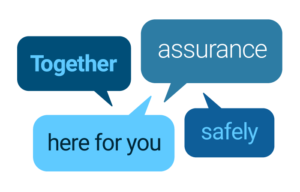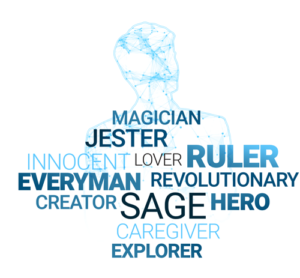At Imaginuity, we have a proprietary, proven way of successfully positioning brands. Two of the key steps are defining the “Messaging Hierarchy” and identifying the right brand “Archetype”, or brand voice. Considering the COVID-19 world we now find ourselves in, it is a good idea to recalibrate both your message and voice to make sure it is aligned with today’s customer expectations.
Is Your Message On Point?
Our “Messaging Hierarchy” is a simple, three-level pyramid starting with a brand’s Attributes on the bottom, followed by Benefits in the middle and Values at the top.
- Attributes: products, services, solutions and brand characteristics
- Benefits: what end results customers can expect by using brand attributes
- Values: essentially the benefits of the benefits—what customers can become or achieve by using what the brand provides

This messaging pyramid is similar to Maslow’s Hierarchy of Needswhere basic human physiological needs (Attributes like food and shelter) are at the bottom of the pyramid and self-actualization (Values like being the best I can be) is at the top. Maslow believed that people had to have foundational needs met before moving up to the next level in the hierarchy.
As we move up our messaging hierarchy to Benefits and particularly Values, brands can differentiate themselves by talking differently about the end-results and unique transformative state they can bring about for their customers. Here is a simple way to think about this pyramid messaging using business clothing as an example:
- Attribute: Black, wool-blend business slacks that cost $150
- Benefit: These pants will match any wardrobe
- Subjective Benefit: A matching wardrobe will make you look great
- Value: (if you look great) People will like you!
It is not uncommon for brands to appeal to consumers at the Value level of the pyramid, appealing to them with aspirational messages (Buy our black, wool-blend business slacks and people will like you.). However, in today’s COVID-19 world, we are recommending that clients take a look at their messaging hierarchy to determine if they are communicating at the right level.
For some, taking a step down from Values to Benefits and even down to Attributes could make sense. Millions have been laid off, most forced into isolation and all dealing with uncertainty the likes of which have never been experienced before; they want to be reassured and comforted—not sold to. People are not making many purchases today to drive self-esteem; they are buying goods and services to satisfy their basic needs at the bottom of the pyramid because they are burdened with worry.
Can I still afford to pay my bills? Am I in danger of losing my home? What items do I have to have? Where can I go to get them? How safe is the environment where I need to make these purchases?
Unlike previous crises, the COVID-19 economic environment has created a number of new challenges. The one constant is that consumers are going to be extremely mindful of their spending. As they tighten their purse strings, they will be focused on buying from reputable brands they know and trust. Brand messaging should be reevaluated accordingly.
Match The Right Message With The Right Voice
Once the right messaging hierarchy has been established, we move to the next step in our brand positioning process, establishing brand voice. To do this, we use the Archetype framework developed by the highly influential psychiatrist Carl Jung over 100 years ago; Jung developed these Archetypes to model human behaviors and personality types. You can think about a brand Archetype similar to a customer persona—what is the brand’s unique and authentic personality, mind set and attitude?
The 12 Archetypes are:
- The Innocent
- The Explorer
- The Magician
- The Revolutionary
- The Sage
- The Hero
- The Lover
- The Caregiver
- The Ruler
- The Creator
- The Jester
- The Every Person
Today, in addition to getting your messaging right, the right brand voice or Archetype is also essential. We are not suggesting repositioning your brand today. Doing so could confuse customers looking for consistency. What we do suggest is taking a second look at your voice—how should it be adapted to provide empathy and build a sense of trust with customers? In today’s highly uncertain world, providing a voice that supports customer new needs, wants and expectations could play a crucial role in the continued success of your brand.
Here are three Archetype examples relative to COVID-19:

- If your Archetype is the Ruler, your focus should be on communicating how you provide time-tested guidelines, processes and steps for customers to follow to establish order, security and stability in uncertain times.
- If the Innocent, you are idealistic, optimistic and hopeful. Many Innocent brands rely on nostalgia to remind customers of how things used to be and should be—certainly a message many people want to hear today.
- If the Hero, your focus is on identifying adversaries and challenges and helping customers overcome them through proven solutions and pathways to success. Pre-COVID-19, a Hero brand’s top-of-pyramid message was all about helping people achieve goals and live their dreams; today it should be about helping people simply persevere.
There have been numerous recently published reports showing how media use has increased significantly over the past few months. This is no surprise considering how many people are isolated at home. However, just because media consumption is on the rise, that does not mean people want to hear the same old tone-deaf marketing messages from brands. Plenty of companies say they understand their customers—now is the time to prove it.
Take a look at your messaging hierarchy. Are you saying things your customers want and need to hear? Is your voice authentic, inspirational and comforting? Getting both the message and voice right will strengthen customer relationships, build brand equity and position the brand for success as we live through and begin to emerge from this crisis.
